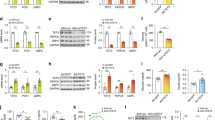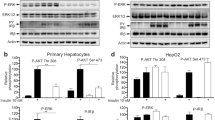Abstract
Insulin gene therapy requires that insulin secretion be coupled to metabolic requirements. To this end, we have developed an insulin transgene whose transcription is stimulated by glucose and inhibited by insulin. Glucose- and insulin-sensitive promoters were constructed by inserting glucose-responsive elements (GlREs) from the rat L-pyruvate kinase (L-PK) gene into the insulin-sensitive, liver-specific, rat insulin-like growth factor binding protein-1 (IGFBP-1) promoter. Glucose (5 to 25 mM) stimulated, and insulin (10−10 to 10−7 M) inhibited, luciferase expression driven by these promoters in primary cultured rat hepatocytes. The capacity of transfected hepatocytes to secrete mature, biologically active insulin was demonstrated using a human proinsulin cDNA (2xfur), modified to allow protein processing by endogenous endopeptidase activity. Medium conditioned by insulin-producing hepatocytes contained greater than 300 μU/ml immunoreactive insulin, while denaturing SDS-PAGE of an anti-insulin immunoprecipitate revealed bands with the mobilities of insulin A, and B chains. Biological activity of hepatocyte-produced insulin was demonstrated in a transfection assay, in which medium conditioned by insulin-producing hepatocytes exerted an effect similar to 10−7 M insulin. We then combined the glucose- and insulin-sensitive promoter with the modified human proinsulin cDNA to create a metabolically sensitive insulin transgene ((GlRE)3BP-1 2xfur). In both H4IIE hepatoma cells stably transfected with this construct, and normal rat hepatocytes (GlRE)3BP-1 2xfur-mediated insulin secretion increased in response to stimulation by glucose. Moreover, a capacity to decrease insulin production in response to diminishing glucose exposure was also demonstrated. We conclude that the transcriptional regulation of insulin production using these glucose- and insulin-sensitive constructs meets the requirements for application in a rodent model of insulin gene therapy.
This is a preview of subscription content, access via your institution
Access options
Subscribe to this journal
Receive 12 print issues and online access
$259.00 per year
only $21.58 per issue
Buy this article
- Purchase on Springer Link
- Instant access to full article PDF
Prices may be subject to local taxes which are calculated during checkout











Similar content being viewed by others
References
Kay MA, Rothenberg S, Landen CN, Bellinger DA . In vivo gene therapy of hemophilia B: sustained partial correction in factor IX-deficient dogs Science 1993 262: 117–119
Applebaum-Bowden D, Kobayashi J, Kashyap VS, Brown DR . Hepatic lipase gene therapy in hepatic lipase-deficient mice. Adenovirus-mediated replacement of a lipolytic enzyme to the vascular endothelium J Clin Invest 1996 97: 799–805
Alino SF, Bobadilla M, Crespo J, Lejarreta M . Human α1-antitrypsin gene transfer to in vivo mouse hepatocytes Hum Gen Ther 1996 7: 531–536
Monahan PE, Samulski RJ, Tazelaar J, Xiao X . Direct intramuscular injection with recombinant AAV vectors results in sustained expression in dog model of hemophila Gene Therapy 1998 5: 40–41
Harding CO, Wild K, Chang D, Messing A . Metabolic engineering as therapy for inborn errors of metabolism – development of mice with phenylalanine hydroxylase expression in muscle Gene Therapy 1998 5: 677–683
Revers RR, Henry R, Schmeiser L, Kolterman O . The effects of biosynthetic human proinsulin on carbohydrate metabolism Diabetes 1984 33: 762–770
Simpson AM, Tuch BE, Swan MA, Tu J . Functional expression of the human insulin gene in a human hepatoma cell line (HEP G2) Gene Therapy 1995 2: 223–231
Simpson AM, Marshall GM, Tuch BE, Maxwell L . Gene therapy of diabetes: glucose-stimulated insulin secretion in a human hepatoma cell line (HEP G2ins/g) Gene Therapy 1997 4: 1202–1215
Groskreutz DJ, Sliwkowski MX, Gorman CM . Genetically engineered proinsulin constitutively processed and secreted as mature, active insulin J Biol Chem 1994 269: 6241–6245
Simonson GD, Groskreutz DJ, Gorman CM, MacDonald MJ . Synthesis and processing of genetically modified human proinsulin by rat myoblast primary cultures Hum Gen Ther 1996 7: 71–78
Lu D, Tamemoto H, Shibata H, Saito I . Regulatable production of insulin from primary-cultured hepatocytes: insulin production is up-regulated by glucagon and cAMP and down-regulated by insulin Gene Therapy 1998 5: 888–895
Muzzin P, Eisensmith RC, Copeland KC, Woo SLC . Hepatic insulin gene expression as treatment for type 1 diabetes mellitus in rats Mol Endocrinol 1997 11: 833–837
Luzi L, Hering BJ, Socci C, Raptis G . Metabolic effects of successful intraportal islet transplantation in insulin-dependent diabetes mellitus J Clin Invest 1996 97: 2611–2618
Fioretto P, Steffes MW, Sutherland DER, Goetz FC . Reversal of lesions of diabetic nephropathy after pancreas transplantation New Engl J Med 1998 339: 69–75
Sugiyama A, Hattori S, Tanaka S, Isoda F . Defective adenoassociated viral-mediated transfection of insulin gene by direct injection into liver parenchyma decreases blood glucose of diabetic mice Hormone Metabol Res 1997 29: 599–603
Kolodka TM, Finegold M, Moss L, Woo SLC . Gene therapy for diabetes mellitus in rats by hepatic expression of insulin Proc Natl Acad Sci USA 1995 92: 3293–3297
Valera A, Fillat C, Costa C, Sabater J . Regulated expression of human insulin in the liver of transgenic mice corrects diabetic alterations FASEB J 1994 8: 440–447
Kaneda Y, Iwai K, Uchida T . Introduction and expression of the human insulin gene in adult rat liver J Biol Chem 1989 264: 12126–12129
Selden R, Skoskiewicz MJ, Burke Howie KB, Russell PS . Implantation of genetically engineered fibroblasts into mice: implications for gene therapy Science 1987 236: 714–718
Robertson DG, Marino EM, Thulé PM, Seneviratne CK . Insulin and glucocorticoids regulate IGFBP-1 expression via a common promoter region Biochem Biophys Res Commun 1994 200: 226–232
Lefrancois-Martinez A-M, Diaz-Guerra M-J, Vallet V, Kahn A . Glucose-dependent regulation of the L-pyruvate kinase gene in a hepatoma cell line is independent of insulin and cyclic AMP FASEB J 1994 8: 89–96
Unger R, Foster DW . Diabetes mellitus. In: Wilson JD et al (eds) William's Textbook of Endocrinology WB Saunders Co: Philadelphia 1998 pp 973–1059
Taconic . Hematological Clinical Chemistry Values Sprague Dawley Rats. Tachonic Technical Library, 1–6. 1998, Internet Communication
Smeekens SP, Chan SJ, Steiner DF . The biosynthesis and processing of neuroendocrine peptides: identification of proprotein convertases involved in intravesicular processing Prog Brain Res 1992 92: 235–246
Steiner DF et al. The new enzymology of precursor processing endoproteases J Biol Chem 1992 267: 23435–23438
Goswami R, Lacson R, Yang E, Sam R . Functional analysis of glucocorticoid and insulin response sequences in the rat insulin-like growth factor-binding protein-1 promoter Endocrinol 1994 134: 736–743
Suh DS, Ooi GT, Rechler MM . Identification of cis-elements mediating the stimulation of rat insulin-like growth factor-binding protein-1 promoter activity by dexamethasone, cyclicadenosine 3′,5′-monophosphate, and phorbol esters, and inhibition by insulin Mol Endocrinol 1994 8: 794–805
Goldstein S, Sertich G, Levan KR, Phillips LS . Nutrition and somatomedin. XIX. Molecular regulation of insulin-like growth factor-I in streptozotocin-diabetic rats Mol Endocrinol 1988 2: 1093–1100
Pao C-I, Farmer PK, Begovic S, Goldstein S . Expression of hepatic insulin-like growth factor-I and insulin-like growth factor-binding protein-1 genes is transcriptionally regulated in streptozotocin-diabetic rats Mol Endocrinol 1992 6: 969–977
Schnetzler B, Murakawa G, Abalos D, Halban P . Adaptation to supraphysiologic levels of insulin gene expression in transgenic mice: evidence of the importance of posttranscriptional regulation J Clin Invest 1993 92: 272–280
Vitullo JC, Aron DC, Miller RE . Control of insulin gene expression: implications for insulin gene therapy J Lab Clin Med 1994 124: 328–334
Leibiger B, Moede T, Schwarz T, Brown GR . Short-term regulation of insulin gene transcription by glucose Proc Natl Acad Sci USA 1998 95: 9307–9312
Gros L, Montoliu L, Riu E, Lebrigand L . Regulated production of mature insulin by non-β-cells Hum Gen Ther 1997 8: 2249–2259
Regazzi R, Verchere CB, Halban PA, Polonsky KS . Insulin production: from gene to granule Diabetol 1997 40: B33–B38
Tomita N, Higaki J, Oghihara T, Kondo T . A novel gene-transfer technique mediated by HVJ (Sendai virus), nuclear protein, and liposomes Cancer Detect Prevent 1994 18: 485–491
Hartwig R, Danishefsky KJ . Studies on the assembly and secretion of fibrinogen J Biol Chem 1991 266: 6578–6585
Dahn MS, Hsu CJ, Lange MP, Kimball SR . Factors affecting secretory protein production in primary cultures of rat hepatocytes (43570) Proc Soc Exp Biol Med 1993 203: 38–44
Dixon JL, Ginsberg HN . Hepatic synthesis of lipoproteins and apolipoproteins Semin Liver Dis 1992 12: 364–372
Vaulont S, Puzenat N, Levrat F, Cognet M . Proteins binding to the liver-specific pyruvate kinase gene promoter. A unique combination of known factors J Mol Biol 1989 209: 205–219
Cognet M, Lone YC, Vaulont S, Kahn A . Structure of the rat L-type pyruvate kinase gene J Mol Biol 1987 196: 11–25
Babajko S, Groyer A . Interplay of the liver-enriched trans-acting factors, DBP and HNF1 in the transactivation of human IGFBP-1 promoter Biochem Biophys Res Commun 1993 196: 480–486
Wanke IE, Wong NC . Specific problems facing gene therapy for insulin-dependent diabetes mellitus: glucose-regulated insulin secretion from hepatocytes Proc Western Pharmacol Soc 1997 40: 131–133
Tuch BE, Tabiin MT, Casamento FM, Simpson AM . Transplantation of genetically engineered insulin-producing hepatocytes into immunoincompetent mice Transplant Proc 1998 30: 473
Seglen PO . Preparation of rat liver cells. III. Enzymatic requirements for tissue dispersion Exp Cell Res 1973 82: 391–398
Ginot F, Decaux J-F, Cognet M, Berbar T . Transfection of hepatic genes into adult rat hepatocytes in primary culture and their tissue-specific expression Eur J Biochem 1989 180: 289–294
Bonifacino J . Analysis of proteins. Current Protocols in Molecular Biology, (10) New York: John Wiley & Sons 1997
Baker A, Saltik M, Lehrmann H, Killisch I . Polyethylenimine (PEI) is a simple, inexpensive and effective reagent for condensing and linking plasmid DNA to adenovirus for gene delivery Gene Therapy 1997 4: 773–782
Marriott D, Gillece-Castro B, Gorman CM . Prohormone convertase-1 will process prorelaxin, a member of the insulin family of hormones Mol Endocrinol 1992 6: 1441–1450
Acknowledgements
This work was funded in part by National Institutes of Health (NIH) grant R01 DK 33475 to LS Phillips. PM Thulé was supported by a VA Merit Review Award, NIH grant NIDDK/NRSA F32 DK08978, and the Veterans Administration. The authors gratefully acknowledge Dr Timothy Stewart and Genentech, Inc., for supplying the modified human pro-insulin cDNA.
Author information
Authors and Affiliations
Rights and permissions
About this article
Cite this article
Thulé, P., Liu, J. & Phillips, L. Glucose regulated production of human insulin in rat hepatocytes. Gene Ther 7, 205–214 (2000). https://doi.org/10.1038/sj.gt.3301076
Received:
Accepted:
Published:
Issue Date:
DOI: https://doi.org/10.1038/sj.gt.3301076
Keywords
This article is cited by
-
Cell biology is different in small volumes: endogenous signals shape phenotype of primary hepatocytes cultured in microfluidic channels
Scientific Reports (2016)
-
Hepatic insulin gene therapy prevents diabetic enteropathy in STZ-treated CD-1 mice
Molecular Therapy - Methods & Clinical Development (2015)
-
Construction of a recombinant human insulin expression vector for mammary gland-specific expression in buffalo (Bubalus bubalis) mammary epithelial cell line
Molecular Biology Reports (2014)
-
Engineered Insulin Secretion from Neuroendocrine Cells Isolated From Human Thyroid
World Journal of Surgery (2014)
-
Treatment of diabetes by transplantation of drug-inducible insulin-producing gut cells
Journal of Molecular Medicine (2009)



